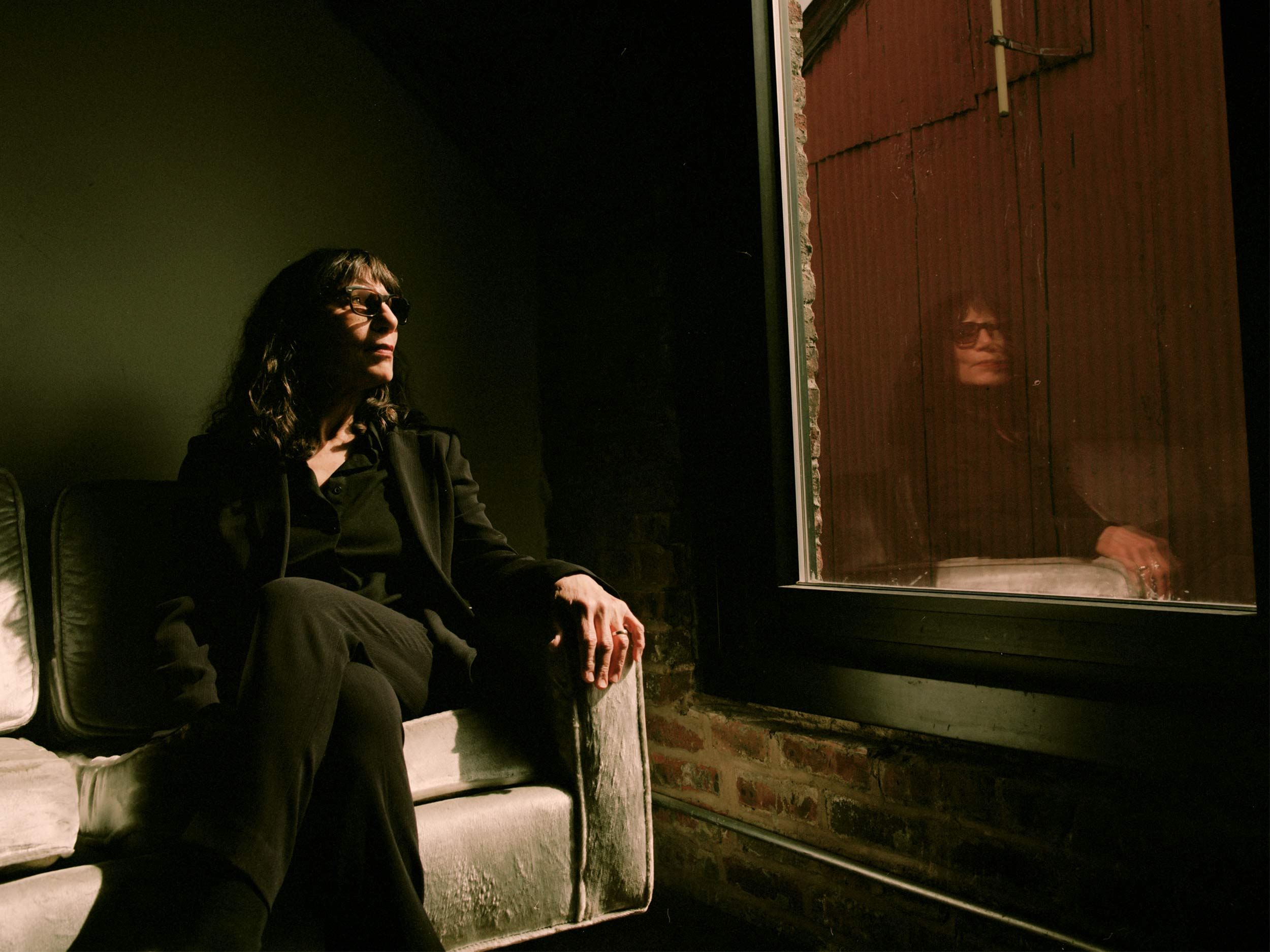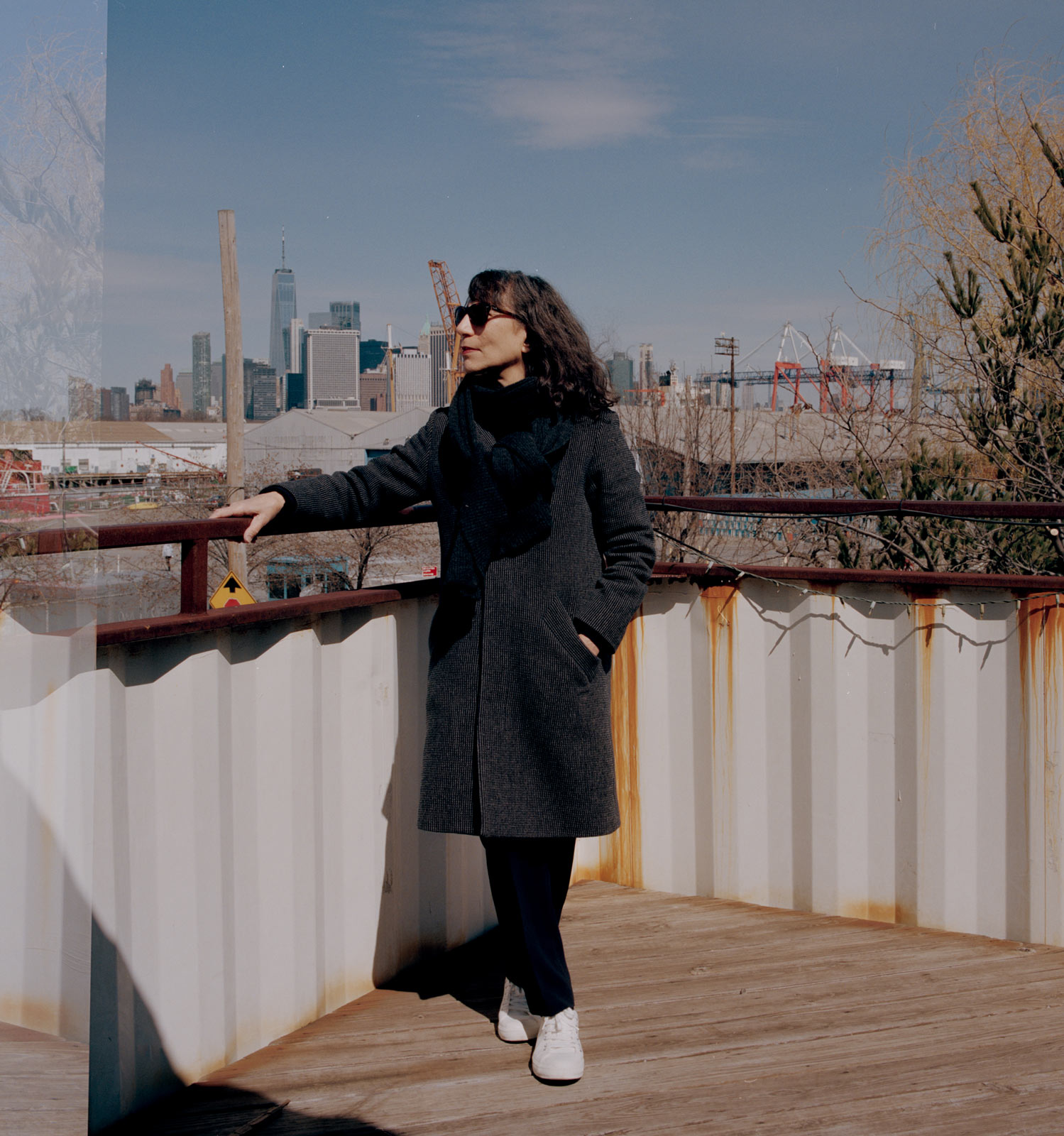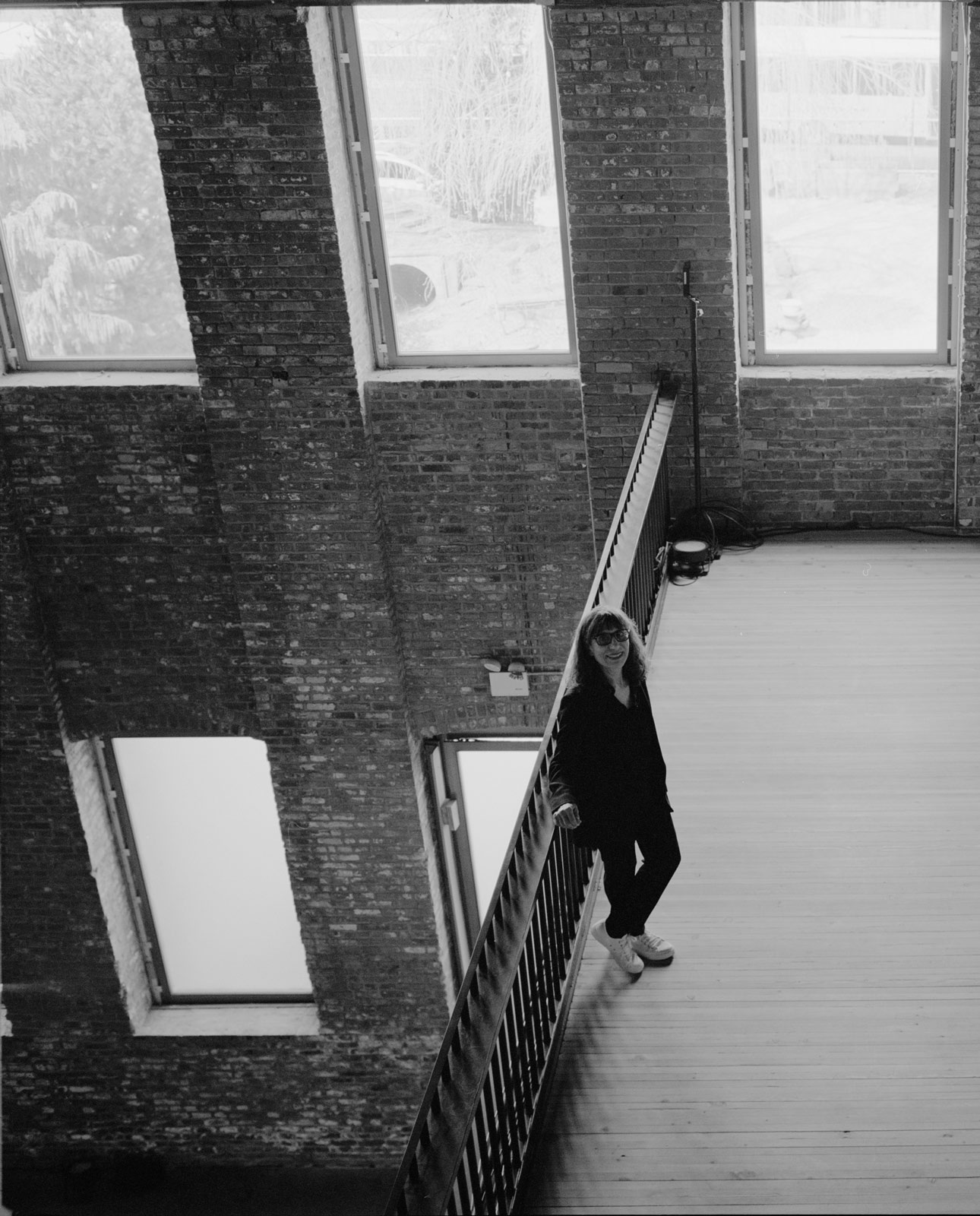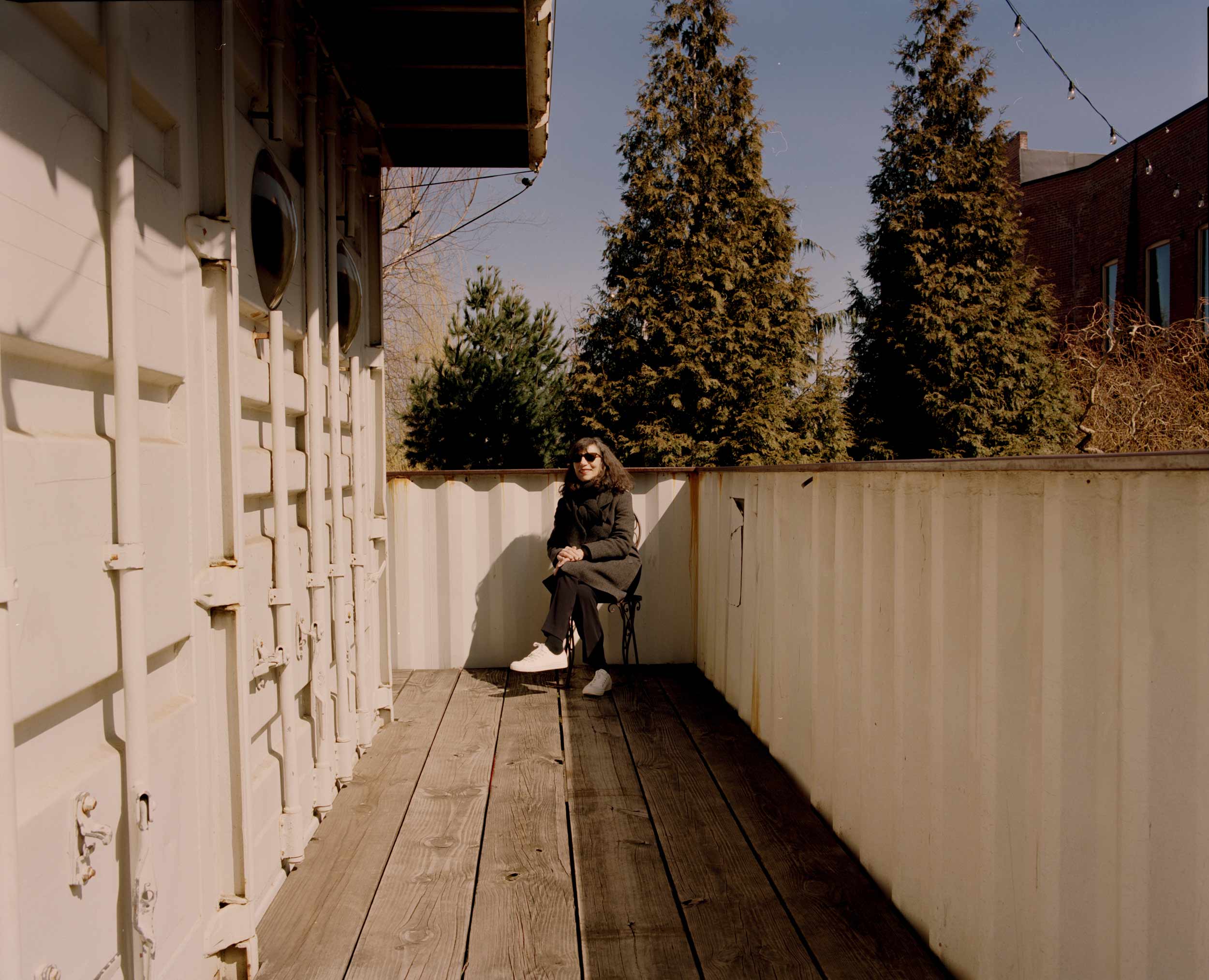The artist joins Document to reflect upon her first institutional survey, which traverses five decades, two spaces, and one book
For some time, while wandering the streets of Sweden, pedestrians might have encountered the performance artist Mike Smith’s face mid-orgasm, plastered onto billboards and buses around the country. The images were part of a safe-sex campaign by the Swedish Federation for Gay and Lesbian Rights, which found the portraits to be rare expressions of male pleasure—in that they depicted male arousal by way of the face—and, therefore, could be used to equate pleasure with safety, at least more so than used condoms or overused (likely feigned) female expressions of eroticism.
The oeuvre of Aura Rosenberg isn’t linear; it’s a web of interconnected ideas and projects and relationships, upon which she is invariably looping backwards and sideways and outwards from. Finding the natural aspects of performance—as she did with that portrait of Smith, from her series Head Shots—is typical of the artist’s impulse. So is its inverse—performance placed within the natural world—most notably, perhaps, in the porn-plastered rocks she wedges onto and within landscapes in The Dialectical Porn Rock. Prolific and interdisciplinary are words wielded liberally in describing the careers of contemporary artists—but if Rosenberg’s works were used as the standard, it’s unlikely they’d easily be applied again. Her practice is ever in flux, adopting new mediums without hesitation (spanning sculpture, painting, photography, film, and installation), and merging them together empirically.
Perhaps it’s that conceptual expanse that made it impossible for her first institutional survey to be contained to just one space. What Is Psychedelic traverses five decades, two locations—Pioneer Works and Mishkin Gallery at Baruch College—and one book. Following the opening of her exhibitions, Rosenberg joins Document to expound upon the makings of the retrospective, her appetite for impulse, and the interconnectivity of her body of work.
Megan Hullander: I wanted to ask you where the title What Is Psychedelic came from—and the lack of a question mark where you might expect one.
Aura Rosenberg: It comes from a painting I made when I was about 22. I had just completed a couple of semesters at the Whitney Museum Independent Study Program. There, I was introduced to Clement Greenberg’s idea that Modernist painting was about reducing itself to the properties that belonged only to painting—flatness, the shape of the support, and the materiality of paint itself. Greenberg’s formalism precluded the depiction of illusionistic space, or the traditional figure-ground relationship. Painting became a fascinating endgame, but I wondered about the rationale behind its drive toward purity.
The answer, for me, was that limiting painting to optical space, to a purely sensory experience, approximated getting high. That was how I lost myself in Pollock’s skeins of paint or Olitski’s fields of color; that was how I understood Modernism and what I wanted to do with my work. My painting What Is Psychedelic featured its title as a graphic. With this, I conflated the visual experience of looking at a painting with what it was saying. Without a question mark, What Is Psychedelic becomes more declarative—a declarative question.
Megan: And what about that piece felt right to use as the title of the exhibition and book?
Aura: Alaina Claire Feldman, director of Mishkin Gallery, asked me to do an exhibition there. I thought it would be interesting to show one work from each of the five decades I’ve been making art. We wanted to publish a book with the show, and Alaina approached the people at Pioneer Works in Red Hook. They offered not only to co-publish the book, but suggested we expand the exhibition to their galleries, as well. I wanted to call the show Five Decades, something straightforward, even a bit bland—but Gabriel Florenz, the artistic director at Pioneer Works, pointed out that many books and shows had already been called Five Decades, and asked me to think of another title.
Alaina and I had uncovered What Is Psychedelic in my storage, with her gallery manager Alex, as well as Amy and Margaret, who had started a business called Registrars Group. Finding the painting coincided with my decision to make a database for my work. As we started pulling out these old paintings, I was amazed that the acrylic paint hadn’t stuck together. The four women found them fresh and relevant—that was very exciting for me, and we brought them to my studio to decide what would go into the show.
What Is Psychedelic struck me and Alaina as formative, something I was thinking about when I was 22 that has carried through till today.
“Painting became a fascinating endgame, but I wondered about the rationale behind its drive toward purity.”
Megan: You mentioned that the work still resonated with these young women after all those years. I think a lot of the themes—especially in terms of gender and sex—that you explored, even in your earliest works, feel really modern. Now, they’ve become much more mainstream subjects for artists. Does it feel more difficult or nuanced to try to be subversive within these contexts as an artist?
Aura: Starting in the ’80s, some of my closest colleagues were my husband, John Miller, and his friend, Mike Kelley. They were role models for me; I saw their work provoking, transgressing—and I wanted to do that, too. But I never wanted to provoke just for the sake of shock.
For example, The Dialectical Porn Rock began as a practical joke when I decoupaged clippings from porn magazines and glued them on rocks. I put the rocks back into a stream for a fisherman friend to find, but, as often happens with jokes, there was a lot of food for thought. I began to photograph the rocks and later arranged them indoors as installations.
Head Shots also started as a joke. Cary Liebowitz, aka Candy Ass, wanted to make a Christmas edition of multiples by artists. He approached me about contributing. At the time, I was working on The Dialectical Porn Rock, and in the back of the New York Times Magazine, I found an ad selling ‘comfort stones’ and decided to make my own for the edition. My friend Mike Smith, the video and performance artist, had been playing at comedy clubs around Christmas dressed like Santa Claus. So I said, ‘Mike, put on your Santa Claus costume, and I’ll photograph your orgasmic face and decoupage the pictures on the rocks.’
Beyond the photo’s absurd humor, Mike and I were struck by the oddness of seeing a man portrayed out of control. I started to look through mainstream media like newspapers, advertising, and movies. I found what amounted to a bias in the representation of masculinity. Men were rarely shown as vulnerable or emotional. In pornography, for example, orgasm was typically represented by a woman’s face; for men, it was ‘the money shot’—ejaculation. That led to Head Shots and my decision only to photograph men. I wanted to give them an unaccustomed view of themselves. It turned out that pictures like these were rare. A group in Sweden producing a safe sex campaign had seen one of them on a magazine cover. They wanted their campaign to equate pleasure with safety, and were having difficulty finding ecstatic portraits of men. So they asked to use Head Shots. They made posters for buses, billboards, and postcards all over cities in Sweden. Also, a t-shirt with Mike’s portrait that said, ‘Come in a condom!’
Megan: The way you talk about your art-making process makes it sound almost passive. How do you go about generating ideas, and at what stage does the medium you want to work in come into play?
Aura: It isn’t passivity, but you’re right that the circumstances of my life offer opportunities to make work. Having a child, I didn’t think, Okay, now I’m gonna make work about motherhood. Not at all. It was more that the responsibilities of motherhood are enormous and I connected with them as both an artist and a mother. Berlin Childhood came about because I was taking photographs of my daughter Carmen and her kindergarten class when we first moved to the city in 1991. Klaus Biesenbach, who was starting out as a curator, wanted to show them. His assistant suggested we title the show Berlin Childhood, after a memoir Walter Benjamin wrote in 1932 when he went into exile. I decided to read it, and found Benjamin’s imagistic writing inspiring. I thought I had finished working with Berlin Childhood until, about 15 years ago, I met one of Walter Benjamin’s granddaughters, Chantal. We became friends, and after she had her daughter, Lais, I started filming them. These films are ongoing. It’s become a decades-long involvement with this work.
My photo series Who Am I? What Am I? Where Am I? also started in Berlin. It was 1992 or ’93, the wall had recently come down, and it was a very xenophobic time. I’m German-Jewish, and Marie, the woman who cared for Carmen’s kindergarten class, was Afro-Deutsch. We often discussed how we felt like part of German culture, but also like outsiders. Once, I brought some face paints from New York City as a gift for the class. When I picked up Carmen later that day, Marie had painted all the kids’ faces, and they came running excitedly toward me. I instantly decided to collaborate with Marie, feeling that it would be a reconciliation for both of us to our lives in Germany. Marie painted the children’s faces, and I photographed them. We did the show later that summer at Künstlerhaus Bethanien.
When the show ended, I thought the project was over. But I began photographing at Carmen’s New York City elementary school as a benefit during their winter fair. The organizers set me up next to the face painting booth, and the kids loved to be photographed with their painted faces. The parents paid $5 for the pictures, and my lab donated the prints. I’d post them on the school bulletin board, and the kids would take them home. All the money went to the school. But I thought, Wow. A child’s face is such a beautiful surface for a painting. But who would take this seriously? Then, one evening, I sat opposite Kiki Smith at a dinner party. She had painted designs all over her face with Kohl powder. And I thought, If I collaborated with established artists, would these face paintings be perceived differently? So I asked Kiki if she would paint Carmen’s face. Kiki wanted to use some rice paper tattoos she had designed. And that was the first photo in the series Who Am I? What Am I? Where Am I? It shows how an interest in the high and low informs my work.
“Partly because I lacked technical training, photography was like magic to me. I wanted to do something unexpected with it, and the rocks offered an unconventional way to shoot landscapes.”
Megan: What’s your relationship to technicality? It seems a lot of your most beloved works are your first experiments in whatever medium they are made from, which is quite unusual.
Aura: I have a fearless side that jumps in and does things, like when I picked up a camera for the first time to shoot The Dialectical Porn Rock pictures. I was entranced by how the decoupaged rocks looked through the lens. I said to my husband, because it was his camera, ‘How many frames do you get on a roll?’ He answered, ‘Typically 24.’ I said, ‘I think I’ve shot over 100.’ That’s when I realized I hadn’t put any film in the camera—my first photo lesson. Partly because I lacked technical training, photography was like magic to me. I wanted to do something unexpected with it, and the rocks offered an unconventional way to shoot landscapes. I simply inserted my rocks into existing scenery, without altering anything other than that.
Over the years, I’ve learned a lot about photo technique. When I began making digital montages for Angel of History, I taught myself Photoshop. For Berlin Childhood, I learned to shoot video. What’s interesting is that, over a period of 15 years, the movies register these changes—some parts are grainy and low resolution, and other parts are 4K.
Megan: How do you think your work in any given medium informs your approach to a different one? For instance, how might your painting practice inform your approach to photography?
Aura: My painting and photography are pretty intertwined. I make the little porn pictures by painting directly on top of a photograph, trying to reproduce it as precisely as possible. This approach reflects my early education as a Modernist formalist. I didn’t want to depict illusionistic space or a conventional figure-ground relationship. Rather, Jasper Johns’s paintings of flags, maps, and numbers, which were already flat, are what influenced me most. I saw my little porn paintings as a way of reintroducing a figure into painting without creating illusionistic space. Of course, their subject matter made them more than just formal studies, but that’s how they began. I later photographed the palettes I used to make the paintings. In this way, painting became photography, while painting over photographs was the inverse. Interestingly, they both represented a kind of unconscious mark-making—since the paintings were dictated by the underlying photo, and the palettes were made without intention, purely as a way to mix color.
The painting of vegetables on the book’s cover is part of a new series made over oilcloth. The oilcloth is meant to be used as a tablecloth. It is typically covered with patterns of flowers, vegetables, and fruits: domestic images. When I started making them, I thought these paintings were unlike anything I’d done before. I was throwing paint at the oilcloth and transforming the patterns into lyrical abstraction. But then I realized that, once again, I was responding to an underlying photograph.
What Is Psychedelic is on view at Mishkin Gallery at Baruch College through June 9, and at Pioneer Works through June 11.

























